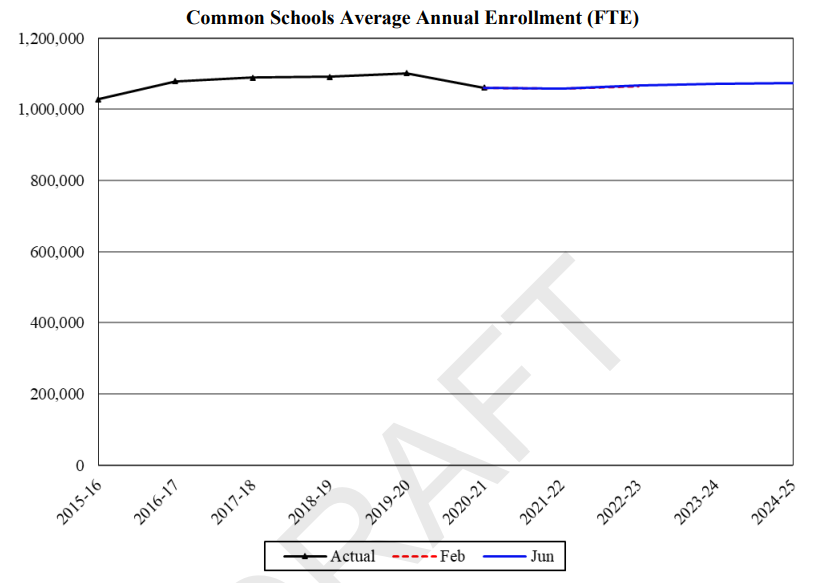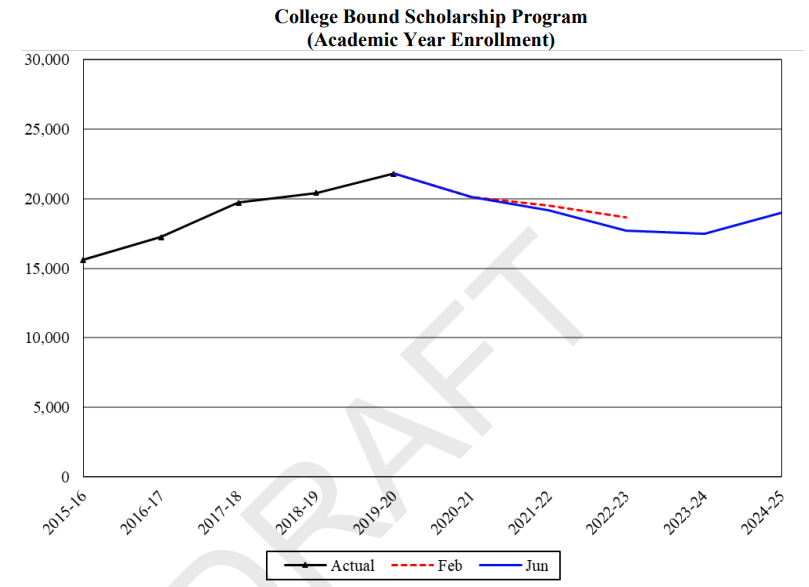2:35 pm
June 15, 2022
The Caseload Forecast Council (CFC) presented the June caseload forecast today. (The charts in this post are from the forecast.)
The new forecast for common schools enrollment is essentially the same as the February forecast, with two additional years. Notably, school enrollment is still not expected to return to pre-pandemic levels. SY 2021–22 appears to be the low point, with enrollment growing slightly in the ensuing years. But SY 2024–25 enrollment is forecast to be just 1,073,337—below SY 2016–17 enrollment of 1,079,421. (The jump in enrollment in SY 2016–17 was related to the implementation of full-day kindergarten.)
In 2021 and 2022, the Legislature appropriated enrollment stabilization funds for districts that lost enrollment compared to SY 2019–20, in the hope that enrollment would quickly bounce back to pre-pandemic levels. This is the third forecast in a row that does not anticipate a bounce-back, which should put an end to such ideas. (For more on K–12 enrollment, see here.)

The common schools enrollment forecast includes K–12 and programs like Running Start. According to CFC staff during the meeting, they “expect a slight rise next year in Running Start due to inflation. We think that Running Start will be one of those programs that people looking for cost savings will go back to.” Specifically, they expect 600 more Running Start students next year.
Conversely, the CFC expects utilization of the College Bound Scholarship Program to continue declining through SY 2023–24. The June forecast is 3.3% lower than in February. Similarly, utilization of the Washington College Grant is now forecast to be 4.3% lower than in February and is expected to decline in each year. According to the forecast,
The WCG became an entitlement during the 2020-21 year, when COVID-19 impacted demand for higher education. The tight labor market has further dampened the demand for higher education in the 2021-22 year and the forecast assumes a 5.2 percent year over year decline. Enrollment is projected to decline another 10.4 percent in the 2022-23 year as a tight job market combined with high inflation has increased the opportunity cost of attending college.
(I wrote about college enrollment in Washington here.)


Other forecasted caseloads are recovering from the pandemic, however. For example, of the Early Support for Infants and Toddlers program, CFC staff said, “We’re seeing families engage in services and so we think we’ve moved past the COVID drop and are back to normal trajectories.”
Meanwhile, it looks like the low points in Corrections caseloads have been reached. These caseloads are expected to start increasing again, though not yet to pre-pandemic levels.
Finally, the forecasts for Medicaid caseloads have increased from February. One of the federal relief bills provided an enhanced federal match for Medicaid during the federal public health emergency (PHE), so long as states do not remove clients from Medicaid during that time. (Kriss wrote about this here.) The February caseload forecast assumed the match and maintenance of effort requirement would be in place until June 30, 2022. The June forecast assumes they will be in place until October 13, 2022. According to the forecast, “After the PHE, we expect large caseload drops in the following months when [the Health Care Authority] starts to re-determine the postponed cases according to federal requirements.”

The Office of Financial Management (OFM) estimates that the new forecast will increase general fund–state costs by $220.6 million in 2021–23. Of that, $165.0 million is related to Medicaid.
During the meeting, OFM Director David Schumacher said the impact in 2023–25 would be about $500 million. Director Schumacher also noted, “we saved an awful lot of money in the underlying budget because a lot of people didn’t come to get the services that they would normally get. So that was a big savings.” But, given some of the forecasted caseloads, “folks are coming back in and those costs are going to come back into the budget.”
Indeed, the maintenance level (the cost of continuing current services, adjusted for enrollment and inflation) dropped significantly in 2022 supplemental budget. Those savings helped offset higher spending on new policies. With the new caseload trends (assuming they continue in the November 2022 and February 2023 caseload forecasts) and increases to inflation, it doesn’t look like the Legislature will be able to rely on maintenance level savings to help balance the 2023 budget.
Categories: Budget.